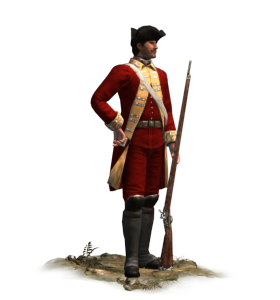Difference between revisions of "Colonial Line Infantry (ETW Unit)"
| Line 3: | Line 3: | ||
|Unit Size=160 men | |Unit Size=160 men | ||
|Weaponry=Muskets | |Weaponry=Muskets | ||
| − | |Region= | + | |Region=The Americas |
|Recruitment Cost=920 | |Recruitment Cost=920 | ||
|Upkeep Cost=230 | |Upkeep Cost=230 | ||
Revision as of 15:55, 18 January 2013
![]() These musket-armed troops use massed volleys to break an enemy, relying on discipline to withstand any counter fire.
These musket-armed troops use massed volleys to break an enemy, relying on discipline to withstand any counter fire.
Overview
“Marching regiments” or “line battalions” make up the majority of units in European-style armies. They are so called because they form the line of battle, not because they always deploy in lines. Indeed, over time the capabilities of line infantry should improve as new tactics, drill and weaponry are developed.
These soldiers carry muzzle-loading, smoothbore muskets firing lead balls as wide as a man’s thumb. These are inaccurate weapons, effective only over 200 paces or so and when fired in massed volleys. The ability to fire and reload with machine-like regularity with shot and bullet flying and comrades falling all around is what wins battles.
Historically, in many armies colonels received a fee to raise regiments, which remained their personal property and commands. They jealously guarded their rights to appoint friends, relatives and hangers-on as regimental officers. This contractor system, however, allowed unscrupulous officers to make handsome profits by pocketing the pay of non-existent soldiers. The better colonels did take a pride in their regiments, spending their own fortunes on good uniforms and weapons. The capabilities of a “standard” line infantry unit therefore varied between nations and over time. It wasn’t until the 1760s that anything approaching uniformity of drill, equipment and regulations became the norm.
Line infantry regiments remained unchanged throughout the period, and their organisational pattern still forms the basis of modern military units.
Details
Colonial line infantry are recruited outside of Europe (including North Africa and the Middle East), and serve the same role as regular line infantry; however, they have different stats from those of European line infantry.
Factions
 Great Britain
Great Britain United Provinces
United Provinces Austria
Austria Bavaria
Bavaria Gran Colombia
Gran Colombia Courland
Courland Denmark
Denmark France
France Genoa
Genoa Georgia
Georgia Greece
Greece Hannover
Hannover Hessen
Hessen Hungary
Hungary Ireland
Ireland Knights of St. John
Knights of St. John Louisiana
Louisiana Maratha Confederacy
Maratha Confederacy Mexico
Mexico Naples & Sicily
Naples & Sicily New Spain
New Spain Norway
Norway Italian States
Italian States Savoy
Savoy Poland-Lithuania
Poland-Lithuania Portugal
Portugal Prussia
Prussia Russia
Russia Quebec
Quebec Saxony
Saxony Scotland
Scotland Spain
Spain Sweden
Sweden Thirteen Colonies
Thirteen Colonies United States
United States Venice
Venice Westphalia
Westphalia Württemberg
Württemberg
